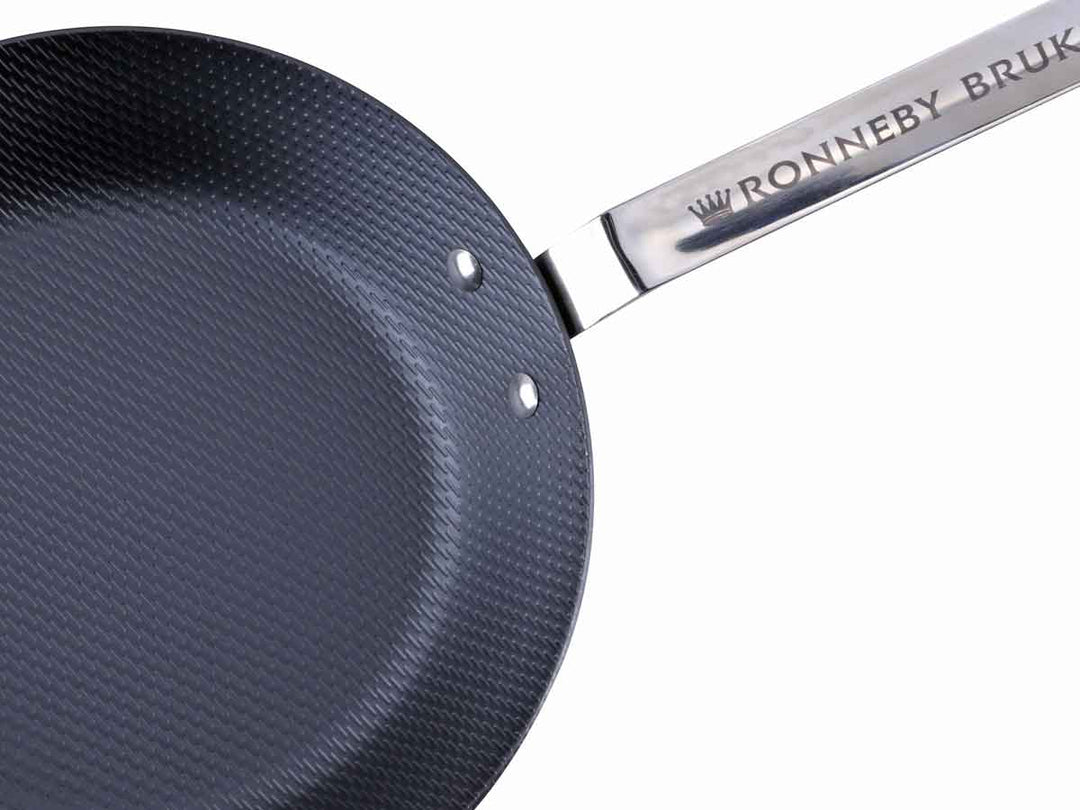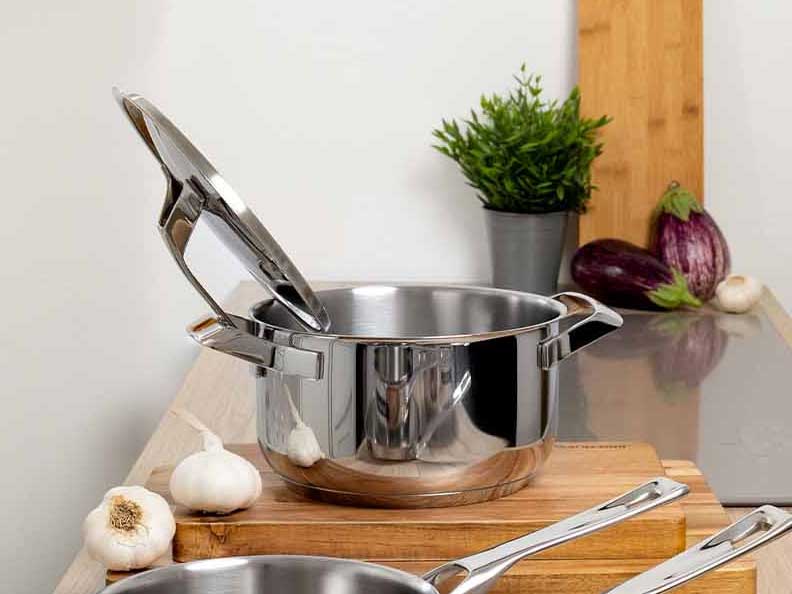Buying advice pans
Foreword
To say it straight away: THE perfect pan does not exist! The requirements that various foods place on the properties of a pan when it is being prepared are almost as diverse and different as the requirements of different users. It is therefore important to us that you find the pan that is as perfect as possible for your personal requirements.
1. Question: What type of pan do you need?
The most common type of pan is without a doubt the normal frying pan , i.e. a mostly circular, rarely square pan with a largely flat bottom, an edge height of between about 4-6 cm and a handle. (Frying pans with two handles attached to the side are also called serving pans.) A frying pan can be used to cook most dishes for frying, so it is a good all-rounder in terms of shape.
With large quantities, however, it becomes problematic due to the rather low height. This is where sauté pans / deep frying pans come into play, which differ from frying pans mainly because they have a higher edge, usually 7-10 cm. Most things can be prepared in a sauté pan like in a frying pan, but of course the high rim can be a hindrance when turning; an omelette or a pancake should therefore not necessarily be fried in a sauté pan. Deep pans with side handles are sometimes also referred to as shallow casseroles; the smooth transition to pots and casseroles is evident here.
This takes us away from the generalists to the real specialists. For example, there are fish pans . These are usually oval, oblong in shape, so a whole fish fits in better than in a regular frying pan. But you can also fry long escalopes well in a fish pan.
Grill pans are often square, have a normal high to rather low rim and have raised grill bars on the bottom. These ensure that the fried food is not only cooked by direct heat conduction (through the grill bars) but also by heat radiation (from the base between the bars), similar to the way on the grill. In addition, leaking meat juice can drain off better than in a normal frying pan, so that the risk of the meat stewing in its own juice instead of frying is reduced.
In Europe, woks are more of a special type of cookware and are usually found with a flat bottom so that they can be used on a normal stove. Designs with long handle and with side handles are common. In addition to dishes from East Asian cuisine, woks are also suitable for many other dishes that require a lot of stirring and mixing and where a high edge is an advantage.
Compared to frying pans, pancake pans have very low rims or no rims at all, so that work with the batter spreader and spatula is not hindered. Due to the almost non-existent rim, pancake pans are of little use for normal frying tasks. If you only prepare pancakes once a year, you don't necessarily need a pancake pan, a normal frying pan will do.
Everything is fine so far? Good. Now that it has been clarified which type of pan you need, we come to the important second question...
2. Question: What type of cook are you?
Based on our many years of experience and a lot of customer feedback, we want to use the following cooking typologies to help you assess which pans (material, coating) could generally be suitable for you. The more honest you are with yourself in the assessment, the better the recommendation will fit.
Note: The periods of use mentioned are pure average values, which can vary significantly upwards or downwards depending on the intensity of use and how the cookware is handled.
a) The occasional cook
- You cook more occasionally and then only when you have to. You wouldn't say that you enjoy cooking.
- You prepare rather uncomplicated, quick dishes or heat up ready meals.
- For you to handle a pan should be possible without much explanation and familiarization, if possible, and the care should take as little time as possible.
- If the pan lasts 2-4 years, that's enough for you, and you give priority to a cheap price when in doubt.
Pan recommendation for the occasional cook
We recommend an entry- to mid-level non-stick frying pan . This allows most dishes to be prepared reasonably well without the cookware being particularly brilliant in any area.
If you are (in our opinion unfoundedly) afraid of classic non-stick coatings (PTFE), but do not want to do without a certain ease of care, then take a look at our ceramic pans, i.e. pans with a ceramic (non-stick) coating.
b) The average cook
- You cook almost every day, sometimes for several people, and now and then take on the challenge of new recipes and complex dishes.
- Despite this, you wouldn't necessarily describe cooking as your favorite hobby or great passion.
- The use of the cookware and its care should be as unproblematic and time-saving as possible for you, but you may also be willing to get involved with the special requirements of a certain pan material and adapt your cooking style accordingly if this promises an advantage.
- In terms of quality, you expect solid performance that you can work with for the next 4-6 years without having to pay a premium price for it.
Pan recommendation for the "normal average cook"
We recommend a non-stick frying pan as part of the basic equipment for easy-to-prepare dishes, if necessary as an addition or alternative to a non-stick sauté pan , depending on your eating habits. In terms of price, you should at least orientate yourself in the mid-level in order to have a coating that can withstand wear and tear longer.
And just like before: If you are afraid of classic non-stick coatings (PTFE) (unfounded from our point of view), but do not want to forego a certain ease of care, then take a look at our ceramic pans, i.e. pans with a ceramic (non-stick -)coating.
In addition, you should think about buying a second pan without a coating for all the dishes that are a bit more rustic and/or need to be fried at higher temps, for example if meat is to be seared particularly sharply and hot, which can lead to overheating in some areas with a non-stick coating under unfavorable circumstances. As the most uncomplicated cookware all around, uncoated stainless steel pans should be considered first.
If you are willing to exercise a little more patience and finesse when it comes to use and care, then iron/carbon steel pans are also worth considering. As a rule, these have to be carefully seasoned before use and otherwise require a somewhat more experienced hand. Well seasoned and cared for, however, it is great cookware that can replace not only the stainless steel pan but also the non-stick pan from time to time.
c) The passionate amateur cook
- You cook almost every day and like to try out new recipes. It doesn't matter to you whether you do it just for yourself or for family / friends / acquaintances.
- For you, cooking is not a burden, but a pleasant part of the day.
- You think of cookware like high-end tools; each has its specific purpose and requires a specific way of dealing with it.
- In terms of quality, you expect well thought-out, solid products that will help you to reliably achieve the desired frying result. If you handle the pan with care, you expect a long product life of >5-10 years and are willing to pay a slightly higher price for it.
Pan recommendation for the passionate hobby cook
If you can get used to the heavy weight of a raw cast iron pan, it will surely become one of your favorite pans over time. To make it easier to get started, you knw that it makes sense to apply a few more seasoning layers before you start.
If you want your pan to react more quickly than a heavy cast iron pan, iron/carbon steel pans are a good addition for you, especially for searing meat, for example.
As a connoisseur in the kitchen, you know that when it comes to sour sauces (tomatoes, red wine), you sometimes have to be careful with raw cast iron pans or iron/carbon steel pans. So for you, an uncoated stainless steel pan or sauté pan is a natural addition to your range of pans, perfect for roasting, braising and sautéing vegetables. For particularly even heat distribution right up to the edge, you are also welcome to look at models with multi-layer technology ( 3-ply or 5-ply ).
And for very delicate dishes, despite your professional skills, you might prefer an easy-care non-stick pan to round off your personal range of frypans. In the mid- to high-end price segment, you're bound to find a durable model that suits your usage habits, whether it's with a riveted, oven-safe professional handle, a detachable handle, or a classic plastic or silicone handle.
Anymore questions?
We will be happy to advise you if you have any further questions or need individual support in deciding on a product. Just send us a message .






